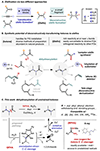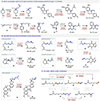Olefination via Cu-Mediated Dehydroacylation of Unstrained Ketones
- PMID: 34807585
- PMCID: PMC9116732
- DOI: 10.1021/jacs.1c09587
Olefination via Cu-Mediated Dehydroacylation of Unstrained Ketones
Abstract
The dehydroacylation of ketones to olefins is realized under mild conditions, which exhibits a unique reaction pathway involving aromatization-driven C-C cleavage to remove the acyl moiety, followed by Cu-mediated oxidative elimination to form an alkene between the α and β carbons. The newly adopted N'-methylpicolinohydrazonamide (MPHA) reagent is key to enable efficient cleavage of ketone C-C bonds at room temperature. Diverse alkyl- and aryl-substituted olefins, dienes, and special alkenes are generated with broad functional group tolerance. Strategic applications of this method are also demonstrated.
Conflict of interest statement
The authors declare no competing financial interests.
Figures





Similar articles
-
Pyridine coordination enabled stepwise PT/ET N-H transfer and metal-independent C-C cleavage mechanism for Cu-mediated dehydroacylation of unstrained ketones.Dalton Trans. 2022 Dec 13;51(48):18409-18415. doi: 10.1039/d2dt03434d. Dalton Trans. 2022. PMID: 36416298
-
From α-arylation of olefins to acylation with aldehydes: a journey in regiocontrol of the Heck reaction.Acc Chem Res. 2011 Aug 16;44(8):614-26. doi: 10.1021/ar200053d. Epub 2011 May 25. Acc Chem Res. 2011. PMID: 21612205 Review.
-
Cu(II)-catalyzed highly regio- and stereoselective construction of C-C double bonds: an efficient method for the ketonization-olefination of indoles.Org Biomol Chem. 2013 Dec 7;11(45):7938-45. doi: 10.1039/c3ob41589a. Epub 2013 Oct 18. Org Biomol Chem. 2013. PMID: 24135895
-
α-Acylation of Alkenes by a Single Photocatalyst.Angew Chem Int Ed Engl. 2022 Dec 23;61(52):e202208831. doi: 10.1002/anie.202208831. Epub 2022 Nov 24. Angew Chem Int Ed Engl. 2022. PMID: 36202761
-
Progress in C-C and C-Heteroatom Bonds Construction Using Alcohols as Acyl Precursors.Molecules. 2022 Dec 16;27(24):8977. doi: 10.3390/molecules27248977. Molecules. 2022. PMID: 36558110 Free PMC article. Review.
Cited by
-
Rapid syntheses of N-fused heterocycles via acyl-transfer in heteroaryl ketones.Nat Commun. 2022 Jun 9;13(1):3337. doi: 10.1038/s41467-022-31063-3. Nat Commun. 2022. PMID: 35680930 Free PMC article.
-
Site-selective amination and/or nitrilation via metal-free C(sp2)-C(sp3) cleavage of benzylic and allylic alcohols.Chem Sci. 2022 Apr 5;13(17):4821-4827. doi: 10.1039/d2sc00758d. eCollection 2022 May 4. Chem Sci. 2022. PMID: 35655896 Free PMC article.
-
Methyl Ketones as Alkyl Halide Surrogates: A Deacylative Halogenation Approach for Strategic Functional Group Conversions.J Am Chem Soc. 2023 Sep 27;145(38):21096-21103. doi: 10.1021/jacs.3c08176. Epub 2023 Sep 15. J Am Chem Soc. 2023. PMID: 37712624 Free PMC article.
-
Deacylative Thiolation by Redox-Neutral Aromatization-Driven C-C Fragmentation of Ketones.Angew Chem Int Ed Engl. 2023 Apr 3;62(15):e202213691. doi: 10.1002/anie.202213691. Epub 2023 Mar 3. Angew Chem Int Ed Engl. 2023. PMID: 36800315 Free PMC article.
-
Aromatization-driven deconstructive functionalization of spiro dihydroquinazolinones via dual photoredox/nickel catalysis.Chem Sci. 2024 May 8;15(23):8993-8999. doi: 10.1039/d4sc01111b. eCollection 2024 Jun 12. Chem Sci. 2024. PMID: 38873081 Free PMC article.
References
-
- March J. March’s advanced organic chemistry: reactions, mechanisms, and structure. eighth. Smith MB editor. John Wiley & Sons, Inc., NJ. 2020, p 891–1085.
-
- Takeda T Modern Carbonyl Olefination: Methods and Applications; Wiley–VCH: Weinheim, Germany. 2006, p 1–338.
-
-
For selected reviews:
- Suess AM.; Lalic G. Copper-Catalyzed Hydrofunctionalization of Alkynes. Synlett 2016, 27, 1165–1174
- Zheng Y; Zi W. Transition-metal catalyzed Enantioselective Hydrofunctionalization of Alkynes. Tetrahedron Lett. 2018, 59, 2205–2213.
- Ananikov VP; Beletskaya IP; Tanaka M Hydrofunctionalization; Springer Berlin Heidelberg: Berlin, Heidelberg, 2013, p 1–19.
-
-
-
For selected reviews, see:
- Flynn AB; Ogilvie WW Stereocontrolled Synthesis of Tetrasubstituted Olefins. Chem. Rev 2007, 107, 4698–4745; - PubMed
- Knowles JP; Whiting A The Heck–Mizoroki Cross-coupling Reaction: a Mechanistic Perspective. Org. Biomol. Chem 2007, 5, 31–44 - PubMed
- Larionov E; Li H; Mazet C Well-Defined Transition Metal Hydrides in Catalytic Isomerizations. Chem. Comm 2014, 50, 9816–9826; - PubMed
- Massad I; Marek I Alkene Isomerization through Allylmetals as a Strategic Tool in Stereoselective Synthesis. ACS Catal. 2020, 10, 5793–5804;
- Zhang J; Lu X; Shen C; Xu L; Ding L; Zhong G Recent advances in Chelation-Assisted Site-and Stereoselective Alkenyl C–H Functionalization. Chem. Soc. Rev 2021, 50, 3263–3314. - PubMed
-
-
- Bhawal BN; Morandi B Catalytic Transfer Functionalization through Shuttle Catalysis. ACS Catal. 2016, 6, 7528–7535;
- Morcillo SP Radical-Promoted C–C Bond Cleavage: A Deconstructive Approach for Selective Functionalization. Angew. Chem., Int. Ed 2019, 58, 14044–14054. - PubMed
Publication types
MeSH terms
Substances
Grants and funding
LinkOut - more resources
Full Text Sources

